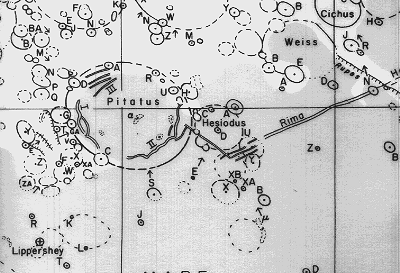
DATE (UT) TIME UT Sun's Sel. Lat. August 23 00h -1.0 degree September 21 13h -0.3 degree October 21 03h +0.5 degree November 19 17h +1.2 degree December 19 08h +1.5 degree
Starting Date = 1998 / 1 / 1 U.T.
Site Longitude = 94.90 Latitude = 39.05 Elevation = 250 meters
Feature = HESIODUS
Longitude = -16°18' Latitude = -29°24'
Reproducing Lighting For: 1996 / 8 / 23 at 0 : 0 UT
Desired Solar altitude = 1.487° (Rising), Azimuth = 90.306°
Average Co-longitude = 18.007
In the time column, D=daylight, T=twilight
---- Moon's ----
Topocentric -- Earth's -- ------- Sun's -------
UT Date Time Alt° Semi-diam" Long° Lat° Colong° Lat° Azim°
1998/ 1/ 7 6: 3 25.57 967.15 2.83 5.51 18.73 1.29 87.68
1998/ 2/ 5 19:54D 10.23 942.33 5.51 6.80 18.38 0.65 88.41
1998/ 4/ 5 21:14D 21.98 909.26 6.51 3.40 17.48 -0.94 90.23
1998/11/27 23:52T 40.82 975.64 -6.43 2.45 18.86 1.52 87.42
* D=daylight; T=Twilight
dates and times for when moon is above the horizon
From the book The Moon, by Moore and Wilkins (Faber & Faber, 1955):
Hesiodus, -245 -490 [Greek poet, circa 735 B.C.]. A crater, 28 miles in diameter to the east of Pitatus, with a pass into the latter and with gaps in its north wall. On the inner north-west is a crater, also a central crater with a smaller crater on its west. On the north is an old ring with a crater and a mountain on the south-east; the wall of the old ring is open on the north. Beyond is a larger ring, with a very broken western rampart and craters on the east. To the east of this ring is the crater, B, and on the north a ridge. West of the larger obscure ring is a low hill with a summit crater. On the south-east wall of Hesiodus is the crater, A, with a complete inner ring on its floor; west of A is a small, low, double ancient ring. A long cleft runs from the north-east wall eastwards to the mountain arm on the north of Cichus, and is continued beyond. A craterlet lies within the cleft near Hesiodus, and there are evidences of others farther east. Thorton found a small central hill in A and has seen the inner ring conspicuous at Full.
Pitatus, -203 -498 [Italian astronomer, circa 1550]. This grand object is a magnificent lagoon-like ring, 50 miles in diameter, on the southern shore of the Mare Nubium. It presents many indications of having suffered from erosion in the past. The northern wall, facing the 'sea' is broken, with wide gaps. The entire walls are, in fact, irregular. On the west crest is a large ring, G, with a feeble central hill; it abuts on a partial ring to the north west. Beyond this is a double crater, and a row of depressions to the crater E. West of E are some lower and imperfect rings. The fragmentary north wall is low, and in the gaps are small craters, while the rampart is straight to Hesiodus. The south wall is ringed with craters just beyond the crest; there are also some on the inner slope. Here and there are great landslips, and south-east lies a double crater. On the interior is not a quite central hill, a crater under the south wall, ridges, hill and a few pits. On the southern portion are two white patches, and another on the north, contrasting with the dark floor of the interior. On the north-western part of the floor there is a cleft, and another on the north-east. Under favorable circumstances, a cleft can be traced all around the interior, close to the walls. A remarkable crater-row lies on the crest of the south-east wall; Nieson mentions five components, but Wilkins shows seven. To the north, and on the Mare, are craterlets, old rings and some hills. On the north-east is a partial ring, F, and south of this is a cleft runs to the north wall of Hesiodus. Where Pitatus joins Hesiodus there is a gap in the wall, so that the interiors are in communication with each other. Wilkins (33-inch O.G.) found eight clefts and forty pits within Pitatus.
